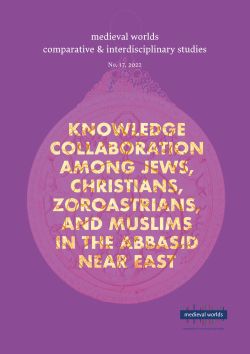 |
 |
Walter POHL – Andre GINGRICH (Eds.) - Nathan Gibson (Guest Ed.)
medieval worlds • no. 17 • 2022
Thomas A. Carlson,
Jessica S. Mutter
S. 185 - 197 doi: 10.1553/medievalworlds_no17_2022s185
Verlag der Österreichischen Akademie der Wissenschaften doi: 10.1553/medievalworlds_no17_2022s185
Abstract:
The medieval Middle East, at the crossroads of Africa and Eurasia, included more distinct yet intersecting literary traditions in more languages than any other part of the premodern world. While several of these literary traditions were religiously demarcated, others such as Arabic and Persian were multireligious written cultures. Despite this, the religious diversity of this region is often conceptualized as separate communities who sometimes interacted. Religion was certainly a socially relevant category employed by medieval people to organize their world, and yet people from every religion wrote about the same government, the same society, and largely the same culture, a culture expressed in religious multiplicity. A new digital research project has developed a reference tool (the Historical Index of the Medieval Middle East, HIMME) to demonstrate the shared culture and society of the diverse medieval Middle East. It provides a union index to selected primary sources in Arabic, Armenian, Greek, Hebrew, Latin, Persian, and Syriac, indexing the people, places, and practices mentioned in each literary tradition. The result is that someone interested in, for example, the famous counter-Crusader Saladin (Ṣalāḥ al-Dīn) can search a database and discover relevant primary sources in unexpected languages such as Syriac as well as the expected Arabic and Latin sources, while the later conqueror Timur Lenk is also mentioned in Greek and Armenian texts that might easily be missed. This article offers an overview of the research tool (published on August 1, 2021), and a discussion of its scope, as well as suggestions for how it might be used to research Jews, Christians, and Muslims in the medieval Middle East.
digital humanities, diversity, multilingualism, Middle East, Arabic, Armenian, Syriac, Persian, Greek, Hebrew Published Online:
2022/11/30 13:02:38 Object Identifier:
0xc1aa5576 0x003ddaca
Rights:https://creativecommons.org/licenses/by-nc-nd/4.0/
medieval worlds provides a forum for comparative, interdisciplinary and transcultural studies of the Middle Ages. Its aim is to overcome disciplinary boundaries, regional limits and national research traditions in Medieval Studies, to open up new spaces for discussion, and to help developing global perspectives. We focus on the period from c. 400 to 1500 CE but do not stick to rigid periodization.
medieval worlds is open to submissions of broadly comparative studies and matters of global interest, whether in single articles, companion papers, smaller clusters, or special issues on a subject of global/comparative history. We particularly invite studies of wide-ranging connectivity or comparison between different world regions.
Apart from research articles, medieval worlds publishes ongoing debates and project and conference reports on comparative medieval research.
Editorial
Ingrid Hartl and Walter Pohl
»The sun was darkened for seventeen days« (AD 797).
An Interdisciplinary Exploration of Celestial Phenomena between Byzantium, Charlemagne, and a Volcanic Eruption
Johannes Preiser-Kapeller and Ewald Kislinger
Knowledge Collaboration among Jews, Christians, Zoroastrians, and Muslims in the Abbasid Near East
Guest editor: Nathan Gibson
Knowledge Collaboration among Jews, Christians, Zoroastrians, and Muslims in the Abbasid Near East: Introduction
Nathan P. Gibson
Why Muslims Shouldn’t Practice Medicine. The Autobiographical Account of a Frustrated Physician, Ibrahīm al-Qalyūbī (fl. second half 7th/13th)
Ignacio Sánchez
Alī and “Sons of Ādurbādh”: Zoroastrians Priests in the Early Islamic Era
Kayla Dang
On Attributes and Hypostases: Muslim Theology in the Interreligious Writings of Patriarch Timothy I (d. 823)
Joachim Jakob
For the Care of Body and Soul: The Greek Bible and an Arab-Islamic Botanical Text in a 10th-Century Palimpsest Fragment
Matteo Pimpinelli
Interreligious Scholarly Collaboration in Ibn al-Nadīm’s Fihrist
Rémy Gareil
Project Reports
Indexing A Shared Knowledge Culture from Many Perspectives: The Historical Index of the Medieval Middle East (HIMME) as a Tool for Researching Diversity
Thomas A. Carlson and Jessica S. Mutter
Embedding Conquest: Naturalizing Muslim Rule in the Early Islamic Empire (Project Report)
Cecilia Palombo
|




 Home
Home
 Print
Print
 References
References
 Share
Share
